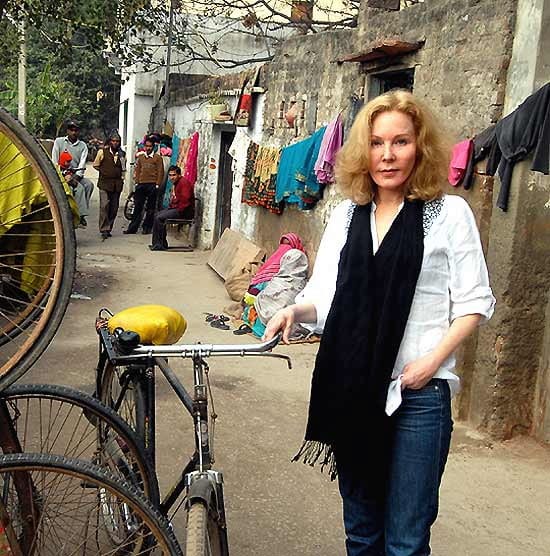
Katherine Boo in Retrospect
December 21, 2018
By Danielle Palmer-Friedman
Katherine Boo is not just a reporter—she’s a sponge. When she’s working on a story, she spends months, sometimes years, thoroughly documenting the lives of families living under extreme inequity. She meticulously records, never disregarding any detail for being too inconsequential. After Boo has gathered the histories, hopes, and abhorrences of the people she is reporting on, she wrings out her collected material and is left with a masterful work of narrative nonfiction.
For twenty years, Boo has authored thoughtful, engaging, and well-researched nonfiction stories. But with such an impressive index of stories to choose from, it can be hard to know where to start. Below is a shortlist of Boo’s most impressive work, ranging from her time at the Washington Post to her full-length book published in 2012.
Start here for context on the author and her writing:
This 2012 Guernica Magazine Q&A with Boo, that’s framed around her book release of Behind the Beautiful Forevers, details Boo’s strategies, philosophies, and goals when it comes to reporting on poverty. Boo elegantly articulates her place in the larger picture while remaining humble, practical, and inspired:
“What it comes down to is, the only thing worse than being a poverty reporter is if no one ever wrote about it at all. My work, I hope, helps people understand how much gets lost between the intellection of how to get people out of poverty and how it’s actually experienced.”
Where it all began:
“Invisible Lives,” a two-part piece published in the Washington Post, won Boo the Pulitzer Prize for Journalism in 2000. The almost 10,000-word piece tells of abuse suffered by mentally disabled adults residing in group homes across Washington, D.C.
It offers a small window into the otherwise ignored world of individuals. It integrates alarming facts and figures to punctuate its point. It will have you in tears by the third paragraph.
The article is Boo’s career in a nutshell—ridiculously strong writing used to elevate issues of inequity and agitate for reform.
Moving forward:
“After Welfare,” published in The New Yorker, won Boo the Sidney Hilman Award in 2002. The article profiles a single mother, Elizabeth “Cookie” Jones, with three children who traded in welfare checks for two jobs. The story contributed to conversations across the country about welfare reform and what it takes to break out of systemic poverty:
“Sometimes Cookie thinks about what her life would be like if she hadn’t left welfare. This speculation requires a tolerance for ambiguity. She wouldn’t have had the clarity and confidence she has now about what she wants for her children—to finish high school without having children and to go to college—but she might have had more time to help them reach those goals.”
If the story and featured individuals spark your interest, this Q&A with Boo, titled “A Better Mother,” offers even more insight into the subject:
“The real story of welfare reform features single mothers improvising like crazy, in a difficult and largely lonesome struggle to live up to the social consensus that they should work.”
And another award goes to:
“The Marriage Cure,” also published in The New Yorker, won Boo the National Magazine Award in 2004. The article instantly transports you into Sooner Haven, a public-housing project in Oklahoma City, with an amazing first sentence, built on the premise of exploring the government-funded “marriage cure” experiment for America’s black urban poor. The story of two friends, Kim Henderson and Corean Brothers, fighting against prejudice and poverty continues to captivate until the very last line. Boo writes with detailed descriptions of everyday discouragements the two women face:
“When a bus turned down [Kim’s] street, she stepped off the curb, but the bus did not slow down. Half an hour later, a second bus cruised by her outstretched, dollar-waving hand. It is an unhappy fact of Oklahoma City life that bus drivers bypass would-be riders in very poor neighborhoods, and blacks in less poor ones.”
The article expands beyond the original premise, a state-sponsored church workshop that offers advice on how to get and stay married, and instead tells a complex narrative of individuals who are ignored or vilified for their race or socioeconomic status.
For the never-ending stack on your bedside table:
Boo’s first and only book, Behind the Beautiful Forevers, won the National Book Award for Nonfiction in 2012. Boo spent three years studying the lives of people living in a slum adjacent to the Mumbai airport. The result is a complex tapestry woven from the storylines of intersecting individuals, all trying to escape the stifling poverty in which they live.
The weight and power of Behind the Beautiful Forevers is a testament to Boo’s methodology as a journalist. She approaches each story with patience and genuine interest. She knows how to shift her focus between the big picture and the tiny detail in order to show a comprehensive perspective. Even more so than in her articles, perhaps because of the space she’s given to write, Boo builds a narrative in Behind the Beautiful Forevers that reads with the hypnotizing pace of your favorite novel.